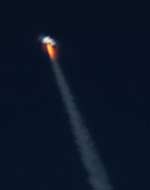
Image credit: Scaled
Scaled Composites’ SpaceShipOne achieved an important milestone this week when it broke the sound barrier on a test flight. The suborbital prototype was carried to 14,600 metres by the White Knight carrier plane, and then released. It fired up its hybrid rocket engine and flew up to an altitude of 20,700 metres, breaking the sound barrier in the process. There was a slight problem with the plane’s landing gear, which caused some minor damage on its landing; it’s going to be easily repaired and there were no injuries. SpaceShipOne is considered the frontrunner to win the $10 million X-Prize.
Today, a significant milestone was achieved by Scaled Composites: The first manned supersonic flight by an aircraft developed by a small company’s private, non-government effort.
In 1947, fifty-six years ago, history’s first supersonic flight was flown by Chuck Yeager in the Bell X-1 rocket under a U.S. Government research program. Since then, many supersonic aircraft have been developed for research, military and, in the case of the recently retired Concorde, commercial applications. All these efforts were developed by large aerospace prime companies, using extensive government resources.
Our flight this morning by SpaceShipOne demonstrated that supersonic flight is now the domain of a small company doing privately-funded research, without government help. The flight also represents an important milestone in our efforts to demonstrate that truly low-cost space access is feasible.
Our White Knight turbojet launch aircraft, flown by Test Pilot Peter Siebold, carried research rocket plane SpaceShipOne to 48,000 feet altitude, near the desert town of California City. At 8:15 a.m. PDT, Cory Bird, the White Knight Flight Engineer, pulled a handle to release SpaceShipOne. SpaceShipOne Test Pilot, Brian Binnie then flew the ship to a stable, 0.55 mach gliding flight condition, started a pull-up, and fired its hybrid rocket motor. Nine seconds later, SpaceShipOne broke the sound barrier and continued its steep powered ascent. The climb was very aggressive, accelerating forward at more than 3-g while pulling upward at more than 2.5-g. At motor shutdown, 15 seconds after ignition, SpaceShipOne was climbing at a 60-degree angle and flying near 1.2 Mach (930 mph). Brian then continued the maneuver to a vertical climb, achieving zero speed at an altitude of 68,000 feet. He then configured the ship in its high-drag “feathered” shape to simulate the condition it will experience when it enters the atmosphere after a space flight. At apogee, SpaceShipOne was in near-weightless conditions, emulating the characteristics it will later encounter during the planned space flights in which it will be at zero-g for more than three minutes. After descending in feathered flight for about a minute, Brian reconfigured the ship to its conventional glider shape and flew a 12-minute glide to landing at Scaled’s home airport of Mojave. The landing was not without incident as the left landing gear retracted at touchdown causing the ship to veer to the left and leave the runway with its left wing down. Damage from the landing incident was minor and will easily be repaired. There were no injuries.
The milestone of private supersonic flight was not an easy task. It involved the development of a new propulsion system, the first rocket motor developed for manned space flights in several decades. The new hybrid motor was developed in-house at Scaled with first firings in November 2002. The motor uses an ablative nozzle supplied by AAE and operating components supplied by SpaceDev. FunTech teamed with Scaled to develop a new Inertial Navigation flight director. The first flight of the White Knight launch aircraft was in August 2002 and SpaceShipOne began its glide tests in August 2003.
Scaled does not pre-announce the specific flight test plans for its manned space program, however completed accomplishments are updated as they happen at our website:
http://www.scaled.com/projects/tierone/index.htm. The website also provides downloadable photos and technical descriptions of the rocket motor system and motor test hardware.
Scaled Composites, LLC, is an aerospace research company located on the Mojave Airport:
Original Source: Scaled Composites
